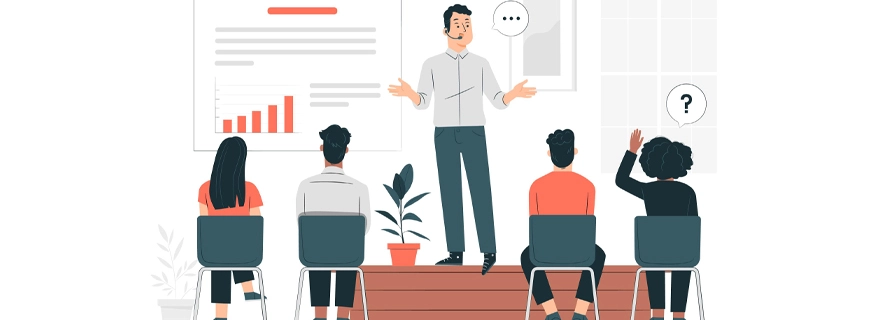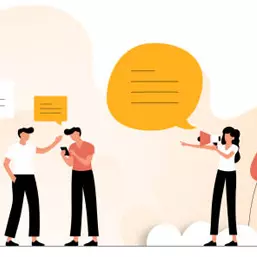
Ground Rules for Q&A
The important thing is not to stop questioning.
– Albert Einstein
Introduction
The way you respond to questions will have a major effect on what kind of rapport you are able to build with the audience. If you answer questions thoughtfully and respectfully, people will feel that you are taking them seriously. If you give flip, dismissive answers, people will feel that you don’t have time for them.
People may ask questions which are not a hundred per cent serious, but even then you should not be dismissive, simply take the question in the spirit it was intended and take the opportunity to display a sense of humor.
Questions may well be an opportunity for you to get information into the presentation that you could not address due to overall time constraints. When someone asks a good question, begin your response with a sentence along the lines of “That’s a very good question, and I am glad you asked me that. I think the most important thing here is that…”
If someone asks a question which you find either you cannot answer or which is difficult, do not simply say “I don’t know” but say “That’s a good question. I have to admit I hadn’t covered that issue – what do you think?” This way you will not lose respect, but will allow discussion to flow more freely.
Rules of Engagement
At the end of your presentation you say, “Does anyone have any questions?” And no one does. What do you do? You could try waiting for 20 seconds or so and then say, “Well, one question people often ask is…” Come up with your own question to show people what kinds of questions you expect.

NOTE: The question you come up with should be an easy one so people will get the idea that they don’t have to ask something very complicated or difficult.
If the presentation is longer than an hour, it is beneficial to allow questions at regular intervals. This is because the longer people are sat in silence, the less interest they will show in whatever is at hand.
However, most presentations will be shorter than that, and it is advisable to hold off questions until the end. If you have an hour in total for the presentation, you should look to wind down at the 45-minute mark and take questions in the last fifteen minutes.
This will allow you to answer questions and look for feedback on those answers. An open question-and-answer session will enliven matters with more group participation. It will give everyone a chance to participate – in a way, which will reinforce what they hopefully have learned.

Responding to Intimidating Questions
Hostile Questions
At some point, someone in your audience might ask a question that sounds like an attack. How should you respond?
- Don’t confront the person. Don’t say, “No, I think you’re wrong.”
- Affirm the person. Say,
“That’s an interesting point, but here’s another way to look at.”
“I can see why you would feel that way, but I was trying to make the point that…”
“Point taken; I might have been too sweeping in my generalization.”
Everyone in the room will be waiting to hear how you respond to the challenge. If you keep cool and say something positive before you proceed to your answer, you will impress your audience with your professionalism and your command of the situation.
- Agree with the person as far as you can. State your disagreement in a non-confrontational way. “I think we agree on XYX, but not on ABC.”
Answering hostile questions with an equally hostile response will simply make the whole process tense. As you are the person at the front of the room, and the person asking the question is sat with a number of other people, it will simply set you against a larger group of people, making the atmosphere needlessly confrontational.
Additionally, if you answer a hostile question by showing good grace and considering the question on its positive merits, you will increase the likelihood of the initially hostile individual backing down from their confrontational position, whether through embarrassment for their unnecessary hostility, or because they were impressed by you looking to answer their question fairly despite the fact that it could have been taken as an attack.
It should be clear that you are not a teacher to the group of people, but some of the principles of teaching remain intact. Among these, the fact that you are in a position of some responsibility and importance should prevent you from allowing yourself to have a pop back at the person.
Confronting Difficult Questions
Listen
- Listen attentively to the question.
- Make eye contact with the questioner.
- Nod or give other indications of encouragement.
- Don’t interrupt.
- Paraphrase when appropriate. If a person asks a long, rambling question, you might want to paraphrase it before you respond. Say something like, “Let me be sure I understand you. You are asking…”

Analyze
- Before responding, make sure you understand the question.
- Try to determine the intent of the questioner. Is he genuinely asking for clarification, or is he trying to disprove or challenge you? Watch facial expression and body language. Listen for tone.
- Ask yourself; is there a broader issue behind the question that I need to address?
Affirm
- Make eye contact with the questioner again.
- Say something like, “That’s an interesting point,” or “I’m glad you brought that up.” An affirmation of this kind is especially important if the question was asked in a challenging way.
Answer
- Don’t duck a question or give a vague answer.
- If you don’t know the answer, say so. You might want to tell the questioner that you will call him the next day with an answer.
- Give an honest answer. If the audience gets the impression that you are trying to put one over on them, you might as well pack up and go home.
The question and answer session traditionally comes at the end of the presentation, so if you shine during this section, people will remember that very clearly, as they will surely remember you negatively if you duck questions or give fraudulent answers. Ending on a positive note is hugely important in a presentation, and if you can do that you are most of the way to being a good public speaker.
Practical Application
Theo had been dreading the question and answer segment. There was one participant, Paris, who had been mumbling under her breath, giving other participants side-glances, and huffing at points he had made. He wasn’t surprised when she was the first one to raise her hand with a question.
When called upon, Paris said, “You say that all customer service representatives must rely on their listening and de-escalation skills. What if you have someone brand new who hasn’t acquired those skills yet? Then, what do you do?”
Theo took a deep breath. He reminded himself not to take the question personally. “Point taken. I might have been too sweeping in my generalization. In that case, it really becomes a training question…”
Theo answered her question honestly and to the best of his ability. This allowed for a smooth transition to the next question that was raised.





